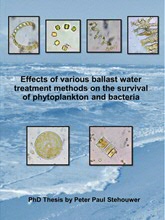Extra rules needed to counter risks posed by ballast water

Peter Paul Stehouwer carried out research at the NIOZ Royal Netherlands Institute for Sea Research into the effects of systems designed to kill unwanted organisms that ‘hitch a ride’ in ballast water. He concluded that although the systems work well, the rules need to be tightened up. He will be awarded a PhD by the University of Groningen on 3 June 2016.
Once ships have been unloaded, they regularly take on water as ballast. As they are reloaded in the next port, the ballast water is discharged and organisms living in the water are unintentionally transported from one port to another.
Plague
An example of an organism that was transported via ballast water is the Chinese mitten crab, which arrived in Rotterdam from Asia and proceeded to colonize large parts of the Netherlands through the Rijn. East European zebra mussels are another example, currently forming a plague in American waters. ‘The USA is spending hundreds of millions of dollars combatting this plague’, says Peter Paul Stehouwer.
Decontaminating
Rules regarding the treatment of ballast water have been devised in an attempt to kill organisms that try to hitch a ride. Stehouwer’s work at the NIOZ involved testing systems for decontaminating ballast water to see whether they satisfy the recent guidelines implemented by the international maritime organization IMO. In addition, he conducted research into the effectiveness of both the equipment and the guidelines.
Two methods
Stehouwer examined two methods commonly used for treating ballast water. The first method involves producing a chlorine compound from seawater (hypochlorite, or bleach) and adding it to the ballast tanks. The second method consists of treating the water with ultraviolet light when it is taken on board, and again when it is discharged. Both treatments ensure that the number of living organisms drops below the IMO standard.
Toxins from algae
But the main focus of Stehouwer ’ s research was on what happens after the treatment. ‘My key question was whether there was evidence of regrowth.’ He concentrated on algae, small organisms which despite their size can be very harmful. ‘Take the proliferation of algae in lakes during the summer months. Toxic substances can develop, causing nasty problems in the human gut. Some tropical species produce substances that are even more toxic.’
99.99 percent
The PhD candidate took ten litres of treated water and cultivated it for three weeks under optimum conditions. The bad news: within those three weeks, algae had started to regrow in every sample that he tested. ‘But there was some good news too. Both treatment methods killed 99.99 percent of all the living organisms in the water. This significantly reduces the risk of species establishing themselves in a new port.’
Tightening up the rules
Stehouwer now recommends tightening up the rules even further. ‘All algae that showed signs of regrowth are smaller than ten micrometres and therefore not covered by the IMO guidelines. The smallest category is from 10 to 50 micrometres.’ This can lead to strange situations. ‘Bacteria are also smaller than 10 micrometres and have no difficulty surviving in the dark and feeding on the remains of the organisms killed by the treatment.’
Right time
New rules covering the category of smallest organisms and bacteria will prevent treatments from stimulating the growth of bacteria, says Stehouwer: ‘The rules are currently the subject of much discussion, so this is the right time to give this some serious thought.’
CV
Peter Paul Stehouwer will be awarded a PhD by the University of Groningen on 3 June 2016. Prof. A.G.J. (Anita) Buma from the Department of Ocean Ecosystems, Energy and Sustainability Research Institute Groningen, was his supervisor and Dr L. (Louis) Peperzak from the NIOZ was his second supervisor. Stehouwer is now working for the German company SGS, which focuses on inspecting and testing industrial installations. He is responsible for testing installations designed to decontaminate ballast water on ships.
More information
Contact: Peter Paul Stehouwer, p.p.v.stehouwer rug.nl or Prof. A.G.J. (Anita) Buma .
Thesis: Effects of various ballast water treatment methods on the survival of phytoplankton and bacteria
| Last modified: | 06 October 2023 3.00 p.m. |
More news
-
15 April 2025
1.5 million funding from Province of Groningen for innovative technology in the region
The University of Groningen will receive nearly 1.5 million euros in funding from the Province of Groningen to assist entrepreneurial academic researchers in developing innovative ideas into a startup.
-
15 April 2025
Nathalie Katsonis wins Ammodo Science Award 2025
For her pioneering research on molecular systems, Nathalie Katsonis receives the Ammodo Science Award for fundamental research 2025.
-
15 April 2025
Fundamental research with life-size effects
Nathalie Katsonis has won the Ammodo Science Award for Fundamental Research. She develops adaptive molecular materials and studies the chemical origins of life, which in turn yield insights for vaccines and clearing up oil spills at sea.
